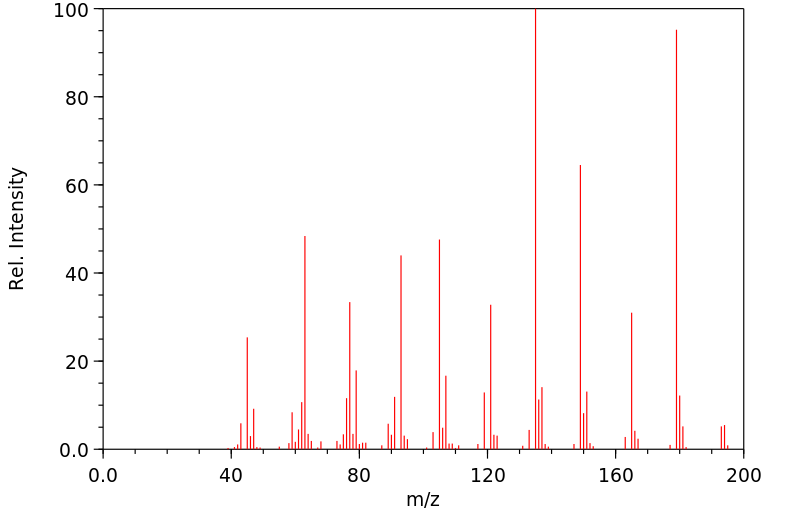Si(OMe)(OEt)3 | 18395-48-7
中文名称
——
中文别名
——
英文名称
Si(OMe)(OEt)3
英文别名
silicic acid triethyl ester-methyl ester;Kieselsaeure-triaethylester-methylester;Methyltriaethylorthosilicat;methyltriethoxyorthosilicate;Triethyl methyl orthosilicate;triethyl methyl silicate
CAS
18395-48-7
化学式
C7H18O4Si
mdl
——
分子量
194.303
InChiKey
QYBKVVRRGQSGDC-UHFFFAOYSA-N
BEILSTEIN
——
EINECS
——
-
物化性质
-
计算性质
-
ADMET
-
安全信息
-
SDS
-
制备方法与用途
-
上下游信息
-
文献信息
-
表征谱图
-
同类化合物
-
相关功能分类
-
相关结构分类
物化性质
-
沸点:91 °C
-
密度:0.946±0.06 g/cm3(Predicted)
-
保留指数:812;807;812.1
计算性质
-
辛醇/水分配系数(LogP):1.18
-
重原子数:12
-
可旋转键数:7
-
环数:0.0
-
sp3杂化的碳原子比例:1.0
-
拓扑面积:36.9
-
氢给体数:0
-
氢受体数:4
上下游信息
反应信息
-
作为产物:描述:甲基三乙氧基硅烷 在 CH3OH 作用下, 生成 Si(OMe)(OEt)3参考文献:名称:Gmelin Handbuch der Anorganischen Chemie, Gmelin Handbook: Si: MVol.C, 136, page 377 - 379摘要:DOI:
文献信息
-
Dehydrogenative coupling of alcohols and carboxylic acids with hydrosilanes catalyzed by a salen–Mn(<scp>v</scp>) complex作者:Srikanth Vijjamarri、Vamshi K. Chidara、Jana Rousova、Guodong DuDOI:10.1039/c5cy01912e日期:——were optimized with different silanes and efficient dehydrogenative coupling was achieved by using triethoxysilane and diphenylsilane. Various alcohols and phenols and a limited number of carboxylic acids were converted into the corresponding silyl ethers and silyl esters. A range of functional groups such as chloro, nitro, methoxy, carbonyl and carbon–carbon multiple bonds are tolerated in the reaction
-
Side Arm Twist on Zn-Catalyzed Hydrosilylative Reduction of CO<sub>2</sub> to Formate and Methanol Equivalents with High Selectivity and Activity作者:Guoqin Feng、Chongyang Du、Li Xiang、Iker del Rosal、Guangyu Li、Xuebing Leng、Eugene Y.-X. Chen、Laurent Maron、Yaofeng ChenDOI:10.1021/acscatal.8b01033日期:2018.5.4for the CO2 hydrosilylation and to explain the relative activity of the zinc catalysts employed in this study. This combined experimental and theoretical study gives insights into the critical effects of the pendant amine donor arm and the size of the alkyl group of the amine on the relative energetics of the species involved in the proposed catalytic cycle.通过基于环境友好的金属如锌的催化剂的CO 2的还原性氢化硅烷化在催化剂选择性和活性方面仍然存在未解决的挑战。在这里,我们显示了由带有侧链胺臂的β-二酮基氨基配体支撑的四配位中性氧化硅锌配合物,对氢硅烷选择性地将CO 2选择性还原为甲酸甲硅酯具有前所未有的高催化活性。更重要的是,该锌催化剂体系还可以以定量收率有效地催化随后的甲硅烷基甲酸酯还原成甲氧基硅烷。了解CO 2的机理合成了氢化硅化反应和侧臂,一系列催化活性物质(或中间体),氢化锌和甲酸酯的影响,并对其结构进行了表征;进行了相关的化学计量反应和动力学研究。还进行了DFT计算,以确定CO 2氢化硅烷化的反应曲线,并解释了本研究中使用的锌催化剂的相对活性。结合实验和理论研究,深入了解了胺侧链供体的关键作用以及胺烷基的大小对拟议催化循环中相关物种的相对能的影响。
-
Catalytic reduction of carbon dioxide by a zinc hydride compound, [Tptm]ZnH, and conversion to the methanol level作者:Serge Ruccolo、David Sambade、Daniel G. Shlian、Erika Amemiya、Gerard ParkinDOI:10.1039/d1dt04156h日期:——The zinc hydride compound, [Tptm]ZnH, may achieve the reduction of CO2 by (RO)3SiH (R = Me, Et) to the methanol oxidation level, (MeO)xSi(OR)4−x, via the formate species, HCO2Si(OR)3. However, because insertion of CO2 into the Zn–H bond is more facile than insertion of HCO2Si(OR)3, conversion of HCO2Si(OR)3 to the methanol level only occurs to a significant extent in the absence of CO2.
-
Nanoporous palladium catalyst for the reduction of aromatic nitro compounds with silane/alcohol system as the hydrogen source作者:Zhiwen Li、Derun Zhao、Jingquan LuoDOI:10.1016/j.inoche.2018.12.004日期:2019.2
-
Hayes, Roger N.; Bowie, John H.; Klass, Gunter, Journal of the Chemical Society. Perkin transactions II, 1984, # 7, p. 1167 - 1174作者:Hayes, Roger N.、Bowie, John H.、Klass, GunterDOI:——日期:——
表征谱图
-
氢谱1HNMR
-
质谱MS
-
碳谱13CNMR
-
红外IR
-
拉曼Raman
-
峰位数据
-
峰位匹配
-
表征信息
同类化合物
(2-溴乙氧基)-特丁基二甲基硅烷
鲸蜡基聚二甲基硅氧烷
骨化醇杂质DCP
马沙骨化醇中间体
马来酸双(三甲硅烷)酯
顺式-二氯二(二甲基硒醚)铂(II)
顺-N-(1-(2-乙氧基乙基)-3-甲基-4-哌啶基)-N-苯基苯酰胺
降钙素杂质13
降冰片烯基乙基三甲氧基硅烷
降冰片烯基乙基-POSS
间-氨基苯基三甲氧基硅烷
镓,二(1,1-二甲基乙基)甲基-
镁,氯[[二甲基(1-甲基乙氧基)甲硅烷基]甲基]-
锑,二溴三丁基-
铷,[三(三甲基甲硅烷基)甲基]-
铂(0)-1,3-二乙烯-1,1,3,3-四甲基二硅氧烷
钾(4-{[二甲基(2-甲基-2-丙基)硅烷基]氧基}-1-丁炔-1-基)(三氟)硼酸酯(1-)
金刚烷基乙基三氯硅烷
酰氧基丙基双封头
达格列净杂质
辛醛,8-[[(1,1-二甲基乙基)二甲基甲硅烷基]氧代]-
辛甲基-1,4-二氧杂-2,3,5,6-四硅杂环己烷
辛基铵甲烷砷酸盐
辛基衍生化硅胶(C8)ZORBAX?LP100/40C8
辛基硅三醇
辛基甲基二乙氧基硅烷
辛基三甲氧基硅烷
辛基三氯硅烷
辛基(三苯基)硅烷
辛乙基三硅氧烷
路易氏剂-3
路易氏剂-2
路易士剂
试剂Cyanomethyl[3-(trimethoxysilyl)propyl]trithiocarbonate
试剂3-[Tris(trimethylsiloxy)silyl]propylvinylcarbamate
试剂3-(Trimethoxysilyl)propylvinylcarbamate
试剂2-(Trimethylsilyl)cyclopent-2-en-1-one
试剂11-Azidoundecyltriethoxysilane
西甲硅油杂质14
衣康酸二(三甲基硅基)酯
苯胺,4-[2-(三乙氧基甲硅烷基)乙基]-
苯磺酸,羟基-,盐,单钠聚合甲醛,1,3,5-三嗪-2,4,6-三胺和脲
苯甲醇,a-[(三苯代甲硅烷基)甲基]-
苯并磷杂硅杂英,5,10-二氢-10,10-二甲基-5-苯基-
苯基二甲基氯硅烷
苯基二甲基乙氧基硅
苯基二甲基(2'-甲氧基乙氧基)硅烷
苯基乙酰氧基三甲基硅烷
苯基三辛基硅烷
苯基三甲氧基硅烷







